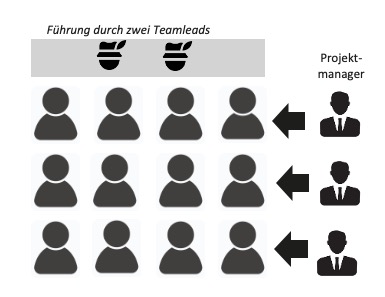Spotify is on everyone’s lips with an agile model made up of squads. Squads are loose groups that have a specific purpose and work in an agile manner. Each squad has an elected squad leader who represents the interests of the team. The squadlead is a “weak” professional leadership role – in my experience, technical knowledge is very important. He is an escalation authority and reports to a TribeLead, Teamlead or department head. All squads have a full IT infrastructure to work autonomously.
In the course of my role as a consultant to the board of directors, I worked out a model for a company to sensibly establish squads in the company with both classic hierarchies and agile departments. Of course, an agile coach can now say: It is not intended that way – but agile concepts always apply to the current situation – and that is often the classic hierarchy in the company to be adapted.
Reading tip: What is the Spotify model
Classic squads
I have two possible concepts to be derived from squads. Concept 1 are classic squads. The squads divide a team vertically and fit perfectly into any classic hierarchy with a team leader. The team leader assigns a specific topic to selected groups of people and appoints a squadlead who is available as an escalation instance for the topic and a contact person for the employees. He reports directly to the team leader. Outwardly, he is authorized to represent the subject.
The classic squad divides an existing team into individual subgroups according to existing industries / customers or technologies and is very stable. You should therefore choose topics that are part of a team, have a long history and do not have much to do with each other. The following applies: The topics in the squad are close together while the topics in the squads themselves are far apart – similar to clusters. “The core idea of a cluster is that objects in the same cluster have” similar “properties and are different from objects that are not in the same cluster” (Source Wikipedia ).
In this model, the squad leads report to the team leader and are, so to speak, sub-groups of teams.

Agile squads
The second concept is agile squads. A department or large team has to organize itself according to an agile model. Team leaders are directly responsible for the disciplinary issues of the employees (people management). In this case, the respective squad leads are, for example, product owners or project managers and report to the department head.
Each squadlead has an assigned group of employees, which he leads professionally. The organization of the department and squad leads is based on technical topics. Each squad lead (product owner) is the contact person for a technical topic and the members of a squad change significantly more frequently than with classic squads.
The main difference to classic squads is that the squad leader is integrated horizontally in the organization and reports to the department head. He is also the contact person for a topic and has various employees available while in the first model the team leader is the contact person.
In the following I show the transformation of a department with many technical topics. The team lead was actually constantly jumping and very overwhelmed. For this purpose, it can make sense to outsource the topics to product owners who are technically responsible for the complex topics. The team lead takes over the resource management.

Another approach can be used in a project-oriented department. For this purpose, the projects can simply be divided up between project managers who take on responsibility. This concept in particular can be implemented very quickly and easily. It is only important that the management is partially transferred to the project manager together with HR.

Conclusion
The two models shown help that squad concepts can be established in a classic organization. Of course, these are not 100% agile, but such a high level of agility does not always make sense and it is important to introduce agile concepts into the classic organization in order to improve iteratively.
It is also possible to establish the squad models in job advertisements and organizational charts together with the HR department. It definitely helps to be able to take the first step in coordination with parts of the company. Agile concepts do not remain isolated solutions but are officially anchored in the company.
Afterwards it is possible to go one step further to Tribes or simply to keep the status, since a significantly higher flexibility and agility in the company is already achieved. It is important to precisely define the position of the squad lead and to firmly anchor the appointment process.
Reading tip: Spotify in traditional companies
[werbung] [fotolia]


